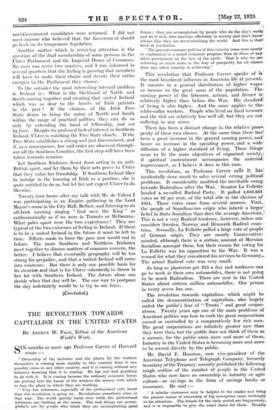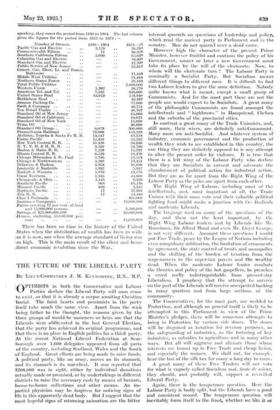THE REVOLUTION TOWARDS CAPITALISM IN THE UNITED STATES
BY ARTHUR W. PAGE, Editor of the American World's Work.
SIX months or more ago Professor Carver of Harvard wrote :- "Ownership of the factories and the plants by the workers themselves is coming mom rapidly in this country than it can possibly come in any other country, and it is coming without any reformer knowing that it is coming. He has not had anything to do with it. It is coming because the ordinary economic forces are putting into the hands of the workers the money with which to buy the plant in which they are working.
"Very few reformers, especially of the professional sort, know that this revolution is going on. Revolutions sometimes come in that way. The world quietly turns over while the professional reformers are barking at the moon. The real things are accom- plished, not by people who think they are accomplishing great
things ; they are accomplished by people who do the day's works and do it well, who function efficiently in society and don't know4 always that they are revolutionizing the world. And this is that kind of revolution.
" The general economic policies of this country come more nearly to conforming to a sound economic program than do those of any other government on the face of the earth. That is why we are achieving so much more in the way of prosperity for all classeo, than any other country is achieving."
This revolution that Professor Carver speaks of is!
the most beneficent influence in American life at present.: It consists in a general distribution of higher wages or income to the great mass of the population. The' earning power of the labourer, artisan, and farmer is I relatively higher than before the War. His standard! of living is also higher. And the same applies to the, white-collar workers. People who lived on fixed incomes' and the rich are relatively less well off, but they are not suffering in any sense.
There has been a distinct change in the relative pros.' perity of these two classes. At the same time there hash been a great increase in the general earning power, and I hence an increase in the spending power, and a wide' diffusion of a higher standard of living. These things' seem to be the main objectives of organized society,i if spiritual contentment accompanies the material! improvement, as I believe it does in this case.
This revolution, as Professor Carver calls it, has incidentally done much to solve several vexing political! problems. It considerably modified the inevitable swing; towards Radicalism after the War. Senator La Follette; headed a so-called Radical Party. It polled 4,686,681. votes or 16 per cent. of the total role in the election of 1924. These votes came from several sources. First,4 the people of Scandinavian origin who inherit a larger' belief in State Socialism than does the average American.) This is not a very Radical tendency, however, unless one considers Sweden, Norway and Denmark Radical coun- tries. Secondly, La Follette polled a large vote of people' of German origin. They are mostly Conservative- minded, although there is a certain amount of Marxian Socialism amongst them, but their reason for voting for La Follette was his opposition to the War. It was a reward for what they considered his services to Germany.4 The actual Radical vote was very small.
As long as plasterers get $15 a day and workmen can go to work in their own automobiles, there is not going to be much Radicalism. There are now in the United States about sixteen million automobiles. One person. in every seven has one.
The revolution towards capitalism, which might be called the democratization of capitalism, also largely ended the public's fear of " Trusts " and great corpor- ations. Twenty years ago one of the main problems of American politics was how to curb the great corporations owned or controlled by a comparatively few rich men. The great corporations are infinitely greater now than they were then, but the public does not think of them as a menace, for the public owns more and more of them.. Industry in the United States is becoming more and more to be owned directly by the public.
Mr. David F. Houston, now vice-president of the American Telephone and Telegraph Company, formerly Secretary of the Treasury, recently published the following rough outline of the number of people in the United States who now have an ownership in industry or agri- culture—or savings in the form of savings banks or insurance. He said :- " A tabular statement may be helpful to the reader and bring the present status of ownership of big enterprises more strikingly to his attention. The details for the early period are fragmentary, and it is impossible to give the exact dates for them. Broadly
speaking, they cover the period from 1880 to 1904. The last column gives the figures for the period from 1923 to 1924 :-
There has been no time in the history of the United States when the distribution of wealth has been as wide as it is now, nor when the average standard of living was as high. This is the main result of the silent and bene- ficent economic revolution since the War.
Number of Owners. 1880-1904 1923-24
Pacific Gas and Electric . • •
3,128 26,294
,Commonwealth Edison ..
11
36,256
Southern California Edison 2,000
65,636
Columbia Gas and Electric
19,800 Standard Gas and Electric . •
12,700 Public Service of New Jersey ..
25,912 Consol. Gas, Elect, Lt. and Power, Baltimore ..
11,449 Middle West Utilities
21,416 Northern States Power
20,163 Total Public Utilities
2,000,000 Western Union .. 1,382 26,276 American Tel. and Tel. 7,535 343,000 United States Steel 43,019 158,940 Bethlehem Steel ..
49,497 Armour Packing Co.
77,000 Swift & Company
46,751 Ten Retail Trades ..
40,761 Standard Oil of New Jersey
65,000 Standard Oil of California ..
18,025 Standard Oil of New York
15,000 Texas Oil ..
30,000 Standard Oil Group.. 6,078 300,000 Pennsylvania Railroad 29,000 144,228 Atchison, Topeka & Santa Fe R. R. 13,147 67,118 Union Pacific 12,450 52,532 New York Central R. R. 10,320 34,946 N. Y. N. H. & H. R. R. .. 9,560 24,796 Boston & Maine R. R. .. 7,229 16,797 Illinois Central R. R. .. 6,526 19,470 Chicago Milwaukee & St. Paul 5,786 22,518 Chicago & Northwestern .. 4,260 19,451 Delaware & Hudson 3,958 10,850 Louisville & Nashville 1,982 5,947 Norfolk & Western - - 1,876 13,176 Great Northern .. 1,835 44,800 Chesapeake & Ohio .. 1,145 9,320 Southern Pacific .. 968 60,186 Missouri Pacific .. 889 3,345 Northern Pacific .. 17 37,991 Erie R. R. .. 17 14,495 Class I Railroads .. .
800,000 Insurance Companies
45,000,000 Farms covering 72 per cent. of land and 15,000,000 persons
3,500,000 Savings of $21,000,000,000
36,000,000
'Jiomes, sheltering 55,000,000 per-
sons ..
11,000,000











































 Previous page
Previous page